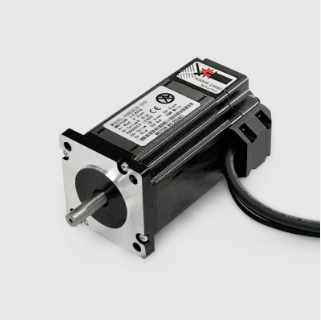Core Components of Servo Drive Control Systems
Servo Drive vs. Controller: Key Functional Differences
When working with servo drive control systems, knowing how servo drives and controllers function differently matters a lot for getting good motion control results. Servo drives basically take commands from the controller and turn those instructions into actual movement of the motor. They handle things like where the motor should be positioned, how fast it needs to move, and what kind of force it must apply, which affects how responsive the whole system feels. Controllers work differently though they look at various inputs to figure out what needs to happen next, then send those orders down to the servo drives. What makes these systems work well together is their reliance on feedback information coming back from the drives. This lets the controller make quick changes when needed to keep everything running smoothly. The constant exchange between drives and controllers through these feedback loops means operators can monitor performance continuously and tweak settings as required, which ultimately leads to better accuracy and more efficient operation in real world applications.
Power Amplifiers and Feedback Loop Essentials
In servo systems, power amplifiers boost those tiny control signals so motors can actually do what they're supposed to. Without this extra kick, the motor wouldn't have enough juice to carry out commands properly. Then there's the whole feedback loop thing which is just as important. These loops constantly watch what's happening and make tweaks on the fly. Think of them like a supervisor checking work quality throughout the day instead of waiting until the end. When something starts going off track, the feedback system catches it right away and brings things back in line with what was planned. Good feedback means fewer mistakes and better results across the board. For anyone working with servo drives, getting both power amplification and solid feedback mechanisms sorted out makes all the difference between a system that works reliably and one that throws errors left and right.
Role of Encoders in Real-Time Position Tracking
Encoders play a key role in servo systems by tracking positions in real time, which helps maintain precise control over movements. The market mainly offers two kinds of encoders these days - incremental ones that track how much something has moved, and absolute encoders that tell exactly where something is located at any given moment. Absolute models are particularly useful because they remember their position even if there's a power outage. Having this kind of position information makes it possible to make fine adjustments when needed, resulting in much better accuracy for moving parts. When encoders send back real time data, they let the system catch and fix small errors almost instantly, which really boosts overall motion accuracy. For industries that need pinpoint accuracy like robotics or automated manufacturing lines, this feature can make all the difference between smooth operation and costly mistakes down the line.
PID Tuning for Precision Motion Control
PID control stands at the heart of precision motion control systems, combining three main components: Proportional, Integral, and Derivative. Each part does something different but important for getting the best results out of these systems. The Proportional component basically tweaks the output depending on how big the error is right now. Then there's Integral, which looks at all those small errors that build up over time. And finally we have Derivative, kind of like looking ahead to see what might happen next based on current rates of change. When put together, this trio helps machines move precisely even when conditions are changing constantly. Getting PID settings just right matters a lot in fields such as robotics work and CNC machining operations because accuracy makes or breaks the whole operation. From planes flying through the sky to cars rolling off assembly lines, manufacturers across many sectors depend on well-tuned PID controllers to keep things running smoothly and meeting quality standards day after day.
How Feedback Signals Correct Motor Output Errors
Feedback signals play a really important role in spotting when motors aren't performing right, which keeps everything running properly. Whenever something goes off track, these signals kick into action, making necessary tweaks to control inputs so errors get fixed fast and performance stays steady. There are plenty of ways to monitor for problems too - think encoders giving position info or sensors picking up on subtle changes in operation. Good feedback systems make a huge difference in how efficiently machines run. Look at what happened in textile manufacturing recently after they upgraded their feedback tech. Output quality became much more consistent across batches, with some factories seeing around a 20% improvement in regularity. This shows just how critical proper feedback loops are for both fixing motor issues and building reliable systems overall.
PWM vs. Analog Voltage Command Structures
Engineers working with servo drives typically face a choice between two main control methods: PWM (Pulse Width Modulation) or traditional analog voltage commands. With PWM, the system adjusts pulse widths to communicate target positions or speeds to motors, which gives pretty accurate control while maintaining good efficiency levels. On the other side of things, analog voltage control works by sending continuous voltage signals that tell the motor what to do. Both approaches come with tradeoffs worth considering. PWM stands out because it handles electrical noise much better than analog and allows for finer adjustments, making it particularly useful when saving power matters most. The downside? It needs more sophisticated circuitry. Analog voltage control remains popular too despite being more susceptible to noise issues. Its main advantage lies in how straightforward it is to implement within older systems already in place.
Industries select between PWM and analog modes based on specific application demands. For instance, robotics and CNC machines might prefer PWM due to its precision and energy benefits. Conversely, older systems or setups where simplicity trumps precision might still employ analog voltage commands.
Fieldbus Protocols for Industrial Network Integration
In industrial settings, fieldbus protocols serve as critical links when connecting servo drives to functional communication networks throughout manufacturing facilities. Among the most commonly used options today are CANopen, EtherCAT, and Modbus. Each brings something different to the table for real time operations where quick and dependable data flow matters. CANopen stands out because it handles complex setups well, making it a go to solution for intricate automation tasks. EtherCAT takes things further with blistering fast transfers that make it ideal for applications requiring split second responses. Then there's Modbus which many engineers still favor despite newer alternatives simply because it's straightforward to set up and maintain, especially in situations where performance requirements aren't so stringent. The right protocol choice often depends on what exactly needs to be accomplished on the factory floor.
Choosing the right fieldbus protocol makes all the difference when it comes to how well a system can scale up or change over time. For industrial automation setups, getting these protocols right means machines talk to each other without hiccups, cuts down on those frustrating shutdowns, and makes expanding operations much less painful. Look at manufacturing plants today they're constantly looking for ways to work smarter not harder. That's why good fieldbus choices aren't just nice to have anymore they're basically table stakes for staying competitive. These protocols help push forward new ideas while keeping everything running smoothly behind the scenes, which matters a lot when production lines need to keep moving day after day.
Robotics and Automated Manufacturing Systems
Servo drives play a key role in making robotic systems more accurate and efficient across manufacturing environments. These drives give robots exceptional control over their movements, allowing them to handle complicated tasks again and again with consistent results. When it comes to factory automation, servo tech helps solve some tough problems around getting parts positioned just right and making quick adjustments on the fly. We see this all over the place in industries where precision matters most. Take automotive plants for instance, where car makers rely heavily on servo driven robots for everything from putting together engine components to final vehicle assembly lines. These machines work fast but still maintain that level of detail required for quality production runs day after day.
High-Speed Packaging Machinery Dynamics
When it comes to fast paced packaging operations, getting good servo control right is absolutely essential. The machines really need quick and spot on movement control if they're going to keep up with production demands while still making sure products look great when they come out. What these servo systems do affects not just how fast things move but also how accurately everything works together in the packaging line. We're seeing some pretty cool changes happening in servo drive tech these days too. Better feedback mechanisms and improved sync between different parts of the machine are changing the game for packaging equipment manufacturers. This means factories can now tackle all sorts of complicated packaging jobs that used to be impossible or at least extremely difficult without breaking a sweat.
Precision in Medical Robotics and CNC Equipment
Accuracy matters a lot in medical robotics and CNC machinery where even small errors can have big consequences. Servo drives are what make those precise movements possible across delicate surgeries and complex manufacturing tasks. These components give machines the steady control needed to operate safely and effectively day after day. Take surgical robots for example they let doctors perform tiny operations inside patients body without making large incisions. Research shows hospitals report fewer mistakes during procedures when their equipment uses servo technology. That explains why so many industries from healthcare to manufacturing keep investing in better servo systems despite the costs involved.
Troubleshooting Common Servo Control Challenges
Resolving Feedback Signal Disruptions
Signal problems in servo control systems happen quite frequently, usually because of faulty sensors, loose cables, or electrical noise getting in the way. When this happens, it messes up how well the system works, causing things to be positioned wrong and operations to slow down. The first step when dealing with such problems is checking all those cables to make sure they're properly connected and looking at sensors for any signs of damage. Getting hold of some good diagnostic equipment helps track down where exactly the signal is breaking down. Regular checkups also matter a lot since they keep those feedback parts working at their best. If left alone, these kinds of signal issues will eat away at productivity over time, not to mention the extra money spent on repairs and lost production hours.
Mitigating Electromagnetic Interference Issues
Electromagnetic interference, or EMI, remains a major headache when trying to keep servo drives running reliably. Common sources range from other electrical gear nearby to power lines running through facilities, sometimes even coming from the drives themselves during operation. When this interference gets into control signals, it creates all sorts of problems that make systems respond slower and less accurately than they should. Shielding is probably the most effective defense against EMI problems. Using properly grounded cables and arranging components strategically goes a long way toward reducing these issues. Most manufacturers follow guidelines set by standards like IEC 61800-3 to check if their systems meet acceptable EMI thresholds. But don't forget regular maintenance either. Testing equipment periodically and making sure everything complies with regulations helps catch potential problems before they cause real damage to system performance.
Table of Contents
-
Core Components of Servo Drive Control Systems
- Servo Drive vs. Controller: Key Functional Differences
- Power Amplifiers and Feedback Loop Essentials
- Role of Encoders in Real-Time Position Tracking
- PID Tuning for Precision Motion Control
- How Feedback Signals Correct Motor Output Errors
- PWM vs. Analog Voltage Command Structures
- Fieldbus Protocols for Industrial Network Integration
- Robotics and Automated Manufacturing Systems
- High-Speed Packaging Machinery Dynamics
- Precision in Medical Robotics and CNC Equipment
- Troubleshooting Common Servo Control Challenges
- Resolving Feedback Signal Disruptions
- Mitigating Electromagnetic Interference Issues

